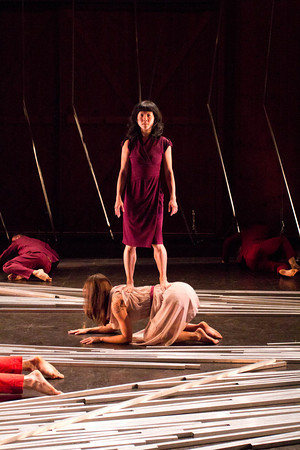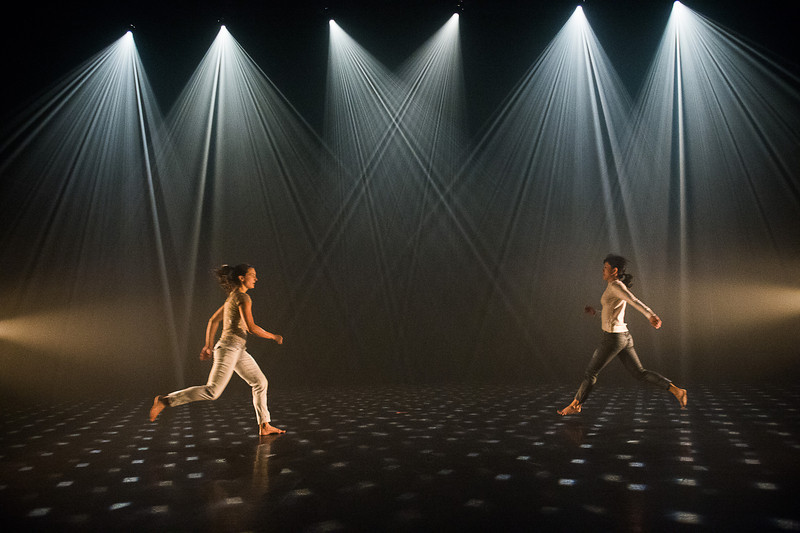Dance Review: Brooking Challenges
Instability is key to Brian Brooks’s choreographic agenda. Some of the dancers crouch on their hands and feet and are transformed into slow-moving mounts for the dancers balancing on their backs.
Brian Brooks Moving Company. Presented by Jacob’s Pillow. At the Doris Duke Theatre, Becket, MA, through July 14, 2013.
By Debra Cash
How the architecture of the urban fabric bears down on us! The straight verticals, the reflective surfaces, the spaces we transverse compressed between walls and boundaried by lines of traffic. Brian Brooks may have grown up in Hingham, MA (he was a student of master jazz dance teacher Jeannette Neill), but his career has made him a New Yorker. That urban identity was vivid in the program his company is dancing at Jacob’s Pillow this week: his is a distinctly hard-edged sensibility.
The seven dancers in his 2012 BIG CITY build Philip Trevino’s set over the course of the piece, attaching rigging to 450 square, aluminum rods until they stand vertically and read as the edges of architectural forms. They don’t start that way, though: when the piece begins, they are spread over the stage floor like reeds. The dancers walk over them carefully, like people getting over a sand-dune on a sizzling boardwalk; you can almost feel their bare soles as the rods shift under their weight and clatter away.
Instability is key to Brooks’s choreographic agenda. Some of the dancers crouch on their hands and feet and are transformed into slow-moving mounts for the dancers balancing on their backs. Brooks has talked about his interest in exploring dancers’ bodies as terrain, and he plays this out when Jo-anne Lee walks into Evan Teitelbaum’s open palms as if his hands on the floor were a tightrope that was constantly being redirected.
BIG CITY is messy on the surface, authoritative underneath. The dancers in their grey and burgundy street clothes—soft frocks for the ladies, a suit jacket and tie for one of the men—whip their arms around as if trying to dislodge swarms of gnats around their heads. Their movements swirl, a spiral vortex against the set’s broken and canted linearity. When finally blonde Bryan Strimpel stands alone motioning an obsessive pattern with his hands, he seems to be tracing the optical illusion of goblet and profile, daring us to make firm distinctions between figure and ground.
Brooks is the distraught guy in his signature 2007 solo I’m Going to Explode. Set to LCD Soundsystem’s “Losing My Edge” it’s as close to a character-driven work as Brooks is likely to get, and he plays the pop references for all they’re worth (“I’m losing my edge to the art-school Brooklynites in little jackets and borrowed nostalgia for the unremembered eighties.”).
Brooks sits down, slips off his businessman’s oxfords, and then roots himself in a constrained space across the room. For its first sequence, he looks like a man who has locked himself in a bathroom stall in order to scream. When his shoulder suddenly wrenches aside and his pulsing arms go out of phase like an errant metronome, the effect is startling and satisfyingly apt.
But in I’m Going to Explode, Brooks loses his choreographic nerve. In what could be a companion piece to Stephen Petronio’s Broken Man (in which Petronio shudders and twists wearing a deconstructed jacket), Brooks cops out and threads his unique movements together with mass-market pops and locks. He performs them convincingly, but it would have been wiser to trust the power of his own minimalism.
Brooks danced with and was rehearsal director for choreographic daredevil Elizabeth Streb. While his 2011 DESCENT does not flirt with physical danger, DESCENT is all about falling and catching, hauling and letting go, which means that it turns on the raw materials of balance, weight, and gravity.
Trevino’s lighting, which picks out the details of the dancers’ faces and knees as if filtered through venetian blinds, gives DESCENT the look of a film noir mystery. But there is whimsy in DESCENT, too, as the dancers fan wisps of white and colored cloth with square, black fans, turning the fabric into clouds and jellyfish, parachutes and snakes drifting overhead. Sometimes all it takes to keep something from the ravages of gravity is a commitment to continual motion.
Brian and Bryan match in more than their names during the gorgeous side-by-side duet excerpt from MOTOR (2010). Dressed only in black trunks, they hop in stuttering motions and one-footed turns, their motion reinforced by the flickering sound and blatting horns of Jonathan Pratt’s musical score. For close observers, there are subtle changes of count and occasional turn-taking. These anonymous athletes look like models for stills from one of Eadweard Muybridge’s photographic studies: they bounce backwards, shoulder to shoulder, into the dark.
Brian Brooks’s choreography will also be featured in Wendy Whelan/Restless Creature at Jacob’s Pillow, August 14–18, 2013, and in Boston presented by the Celebrity Series, March 28–29, 2014.
c 2013 Debra Cash


